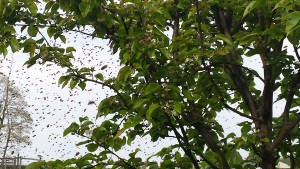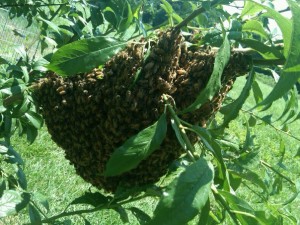Seeing honey bees swarming affects people differently. Beeks start thinking about how to capture the swarm and non-beeks, well, they don’t. If you don’t have bees then this is for you and if you do have bees you may want to share this with your non-beek friends.
I was tagged in a post this morning on Facebook by a friend in Arizona who wrote this.
“I HATE BEES! I have a bee phobia stemming from childhood. I walk out of my garage and there above my head is a huge swarm of bees, not little cute honeybees but Africanized bees. $165.00 later and no more bees. Bees are good for lots of things but these bees met their maker. Sorry Ann Barczewski. If you want to come collect them you can if they come back but not this group.”
Honey bees swarming can be scary, especially if you had a bad experience as a child. To look into the sky and see nothing but bees would freak pretty much anyone out!
So what is one to do? I’m glad she tagged me!
With all the hype from Hollywood about “Killer Bees” it’s no wonder that people are afraid of Africanized bees. It’s incredibly difficult to tell the difference between an African bee and a European bee. The African bee is about 10% smaller than the European bee. That is a very subtle size difference up close, much less from a distance. And I’m talking about bee experts who KNOW what they’re looking at. For most of us, we wouldn’t be able to tell by looking. And that is the pure African bee. Africanized just means that a bee has some African genetics in it and that can only be determined through DNA lab testing.
Honeybees are at their most gentle when swarming (that isn’t to say they won’t sting if they feel threatened) and that includes the Africanized bees. Here is why. The queen produces a pheromone and when she leaves the hive her workers will know where she’s going. The bees who follow her aren’t watching the one in front of them to see where everyone is going. Her pheromone is an invisible trail they’re following. If one of them stings they emit a different pheromone, an alarm pheromone, which covers the queen’s trail and throws them into confusion. Once they can’t smell the queen it’s like she doesn’t exist to them and without a queen they die. That is why they are at their most gentle when swarming. But it is alarming to see the sky full of bees if you don’t know this! I’ve had many a bee bounce off my body, head and even my face during a swarm, but they weren’t being aggressive, they were just flying and I was in their way.
The purpose of a swarm isn’t to live on your garage or hanging from your tree. They’re out looking for a new home. The queen will land and the workers will cluster around her while the scout bees will go search for a suitable new home. The cluster of bees will stay there until the queen moves. If at all possible just avoid the area where the bees are clustered and within a few days they’ll move on. If they’ve chosen to stop in a place you can’t avoid then you need to get some help. And remember, don’t try to move or destroy the swarm yourself. That could backfire on you.
Do nothing if you can avoid the swarm. Keep animals and children away from the area and within a few days they’ll move on to their permanent residence.
If you can’t avoid them (they’re on your porch or near your door) here are some guidelines that may help.
- Never spray them with insecticides or chemicals. Not only is this completely unnecessary, it could provoke them and cause them to attack you. Besides, when you consider all the problems the honeybees are facing and how integral they are to our survival we need to preserve the ones we do have.
- This one probably goes without saying but…don’t throw rocks or sticks at them to get them to move. They’ll resent it, you’ll regret it!
- Contact your local beekeeping association. You can find them by googling local beekeeping association followed by your city and state, usually. Once you reach someone inquire as to whether anyone in their group would be interested in swarm removal. Some do it for no charge (we’ve never charged to remove bees even an established colony in the wall of an old barn) and others charge a fee. Remember that even though they’ll benefit from the bees that they may incur expenses, such as gas, to remove your swarm so look for someone as local as possible.
- If you can’t contact your local beekeeping association then try looking here on the Bee Culture Directory.
Bear in mind that the first beekeeper you contact might not be able to help you (we are usually pretty busy and most of us have a regular job too) for one reason or another (already has too many bees, not enough equipment, not enough time, etc..) and that inexperienced beekeepers might not be comfortable with removing a swarm.
It may seem like a lot of trouble to go through but in the long run you’ll have done your part to ensure the future of our honeybees.












1 Comment
I was excited to see a swarm of honeybees on one of our trees! I am wondering how far from the swarm site they travel to find a new nest. I would love it if they would stick around. The tree they are in has a hollow in it, I’m wondering if they like that for a home. How does someone get them to stick around if they don’t have equipment? I have been searching the internet and mostly what i find is to have someone remove them for humane disposal or kill them with soapy water. I would hope people don’t really do that. I am an avid flower gardener and we have a lot of bees coming round. I’m allergic to them but they never bother me, I go about my business and they do theirs! I haven’t been stung since I was 10, that was 47 years ago. I taught my children and now my grandchildren not to flip out and panic when they see one. I find bees to be quite easy to work around if you stay calm. They land on me, I ignore them and they go away. We all need to educate our next generations not to be afraid of them, I can’t imagine a world without honey!